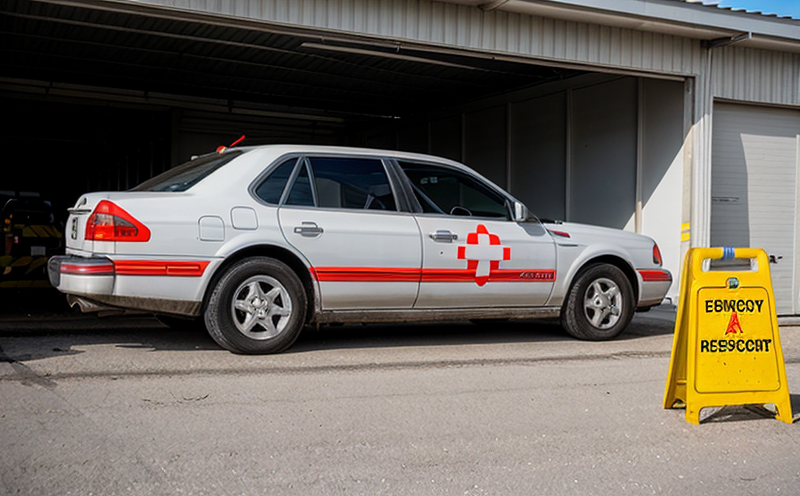Emergency stop inspection
The emergency stop feature is a critical safety mechanism in lifting equipment and cranes. Ensuring this component functions correctly can prevent accidents, injuries, and significant property damage. This inspection involves testing the emergency stop button to verify its immediate and reliable disengagement of all crane mechanisms. Compliance with standards such as ISO 4308 ensures that safety is a priority, protecting not only personnel but also equipment integrity.
The process begins by identifying the emergency stop button on the crane. Upon activation, all operational systems must disengage instantaneously. This includes motors, brakes, and any other moving parts. The inspection aims to confirm the button's effectiveness across various conditions, such as varying loads, environmental factors like temperature changes or humidity levels, and during typical operating scenarios.
The testing process is methodical and involves multiple steps to ensure thoroughness:
- Clearing all systems for the test run to avoid any interference.
- Simulating an emergency scenario where the operator activates the stop button, ensuring all mechanisms comply with immediate disengagement criteria.
- Monitoring the system’s response time and confirming it aligns with industry standards. Typically, this should be under 0.5 seconds for effective safety measures.
- Checking for any residual energy or mechanical movements that could pose a risk after activation.
- Evaluating the button's functionality in different environmental conditions to ensure reliability across all operational contexts.
The results of this inspection are critical, as they directly impact the overall safety and compliance status of the crane. Compliance with standards such as ASTM F2874 is essential to ensure that the emergency stop function meets the necessary criteria for safe operation.
The findings are documented meticulously, providing a detailed report on the performance of the emergency stop button. This document serves as a critical reference for future maintenance and safety audits. By adhering to these stringent inspection protocols, we help ensure the continuous reliability and safety of lifting equipment and cranes in various industrial settings.
Industry Applications
The ISO 4308 standard for emergency stop devices is widely applicable across multiple sectors, including construction, manufacturing, and logistics. In the construction sector, cranes are used extensively in high-rise building projects where precision and safety are paramount. Ensuring that the emergency stop function operates reliably minimizes risks during critical operations.
| Industry | Critical Application | Emergency Stop Requirement |
|---|---|---|
| Construction | High-rise building projects | Immediate disengagement of all mechanisms within 0.5 seconds |
| Manufacturing | Assembly line operations | Ensures safety during heavy lifting and material handling |
| Logistics | Material handling in warehouses | Avoids accidents during peak operational periods |
In manufacturing, the emergency stop function is crucial for preventing damage to machinery and products. During assembly line operations, heavy lifting can pose significant risks if not managed properly. The immediate disengagement of all mechanisms ensures that any unexpected situations are handled safely.
In logistics settings, cranes play a vital role in moving materials efficiently within large warehouses. Ensuring the reliability of the emergency stop function is essential for preventing accidents during peak operational periods when multiple tasks are happening simultaneously. By adhering to international standards such as ASTM F2874, we can provide comprehensive inspections that meet the specific needs of each industry.
Eurolab Advantages
At Eurolab, our commitment to excellence in lifting equipment and crane inspection is reflected in every aspect of our service. Our team of experts ensures that all emergency stop inspections are conducted with the highest level of precision and accuracy.
- Comprehensive Testing: We conduct a thorough evaluation of the emergency stop function, ensuring it meets or exceeds industry standards.
- Expertise in Standards: Our team is well-versed in international standards such as ISO 4308, allowing us to provide inspections that are both rigorous and compliant.
- State-of-the-Art Equipment: Utilizing the latest instrumentation, we ensure reliable and accurate results every time.
- Detailed Reporting: Our comprehensive reports provide detailed insights into the performance of the emergency stop function, offering valuable data for future maintenance and safety audits.
- Customer Satisfaction: We prioritize customer satisfaction by providing timely, accurate inspections that meet or exceed expectations.
- Compliance Assurance: Ensuring compliance with relevant standards is at the core of our service, helping clients maintain a high level of operational safety.
- Long-Term Partnerships: We build long-term relationships by offering consistent quality and reliability in all services provided.
With Eurolab, you can trust that your lifting equipment and cranes are receiving the highest level of care and inspection. Our expertise ensures that every aspect of the emergency stop function is evaluated meticulously, providing peace of mind for operators and personnel alike.





